ASRock FM2A85X Extreme6 Review
by Ian Cutress on December 3, 2012 12:00 PM EST- Posted in
- Motherboards
- AMD
- ASRock
- Trinity
- FM2
USB Speed
For this benchmark, we run CrystalDiskMark to determine the ideal sequential read and write speeds for the USB port using our 240 GB OCZ Vertex3 SSD with a SATA 6 Gbps to USB 3.0 converter. Then we transfer a set size of files from the SSD to the USB drive using DiskBench, which monitors the time taken to transfer. The files transferred are a 1.52 GB set of 2867 files across 320 folders – 95% of these files are small typical website files, and the rest (90% of the size) are the videos used in the Sorenson Squeeze test.
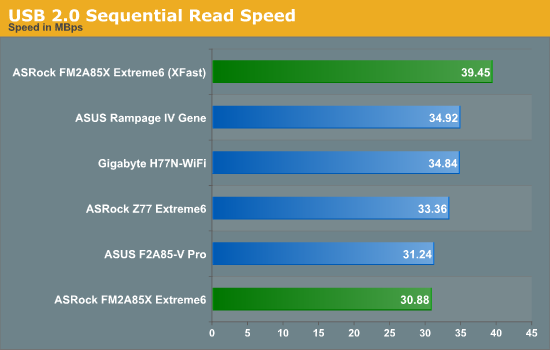
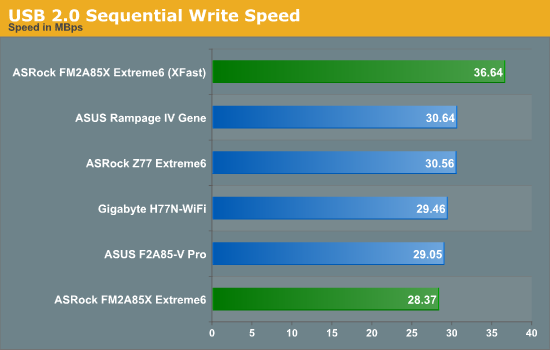
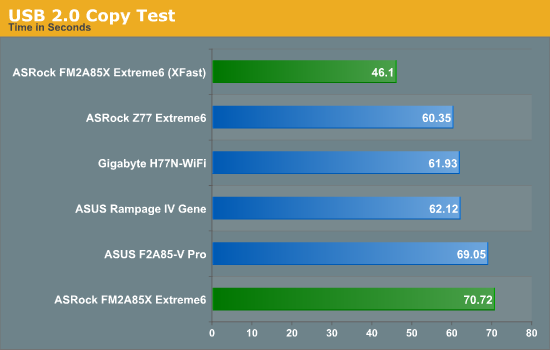
For USB 2.0, it alarmingly comes down to an Intel advantage over AMD. Compared to the ASUS FM2 board we have tested, the ASRock also lags behind slightly. With use of XFast USB however, the ASRock does claw back some time compared to all the other systems.
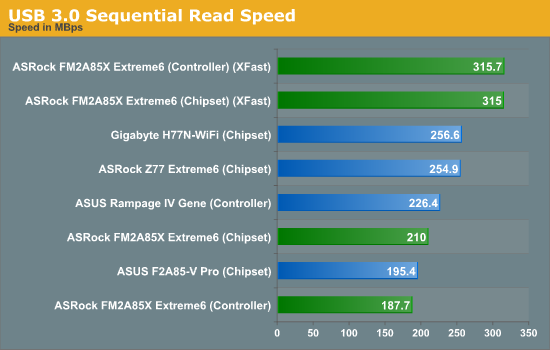

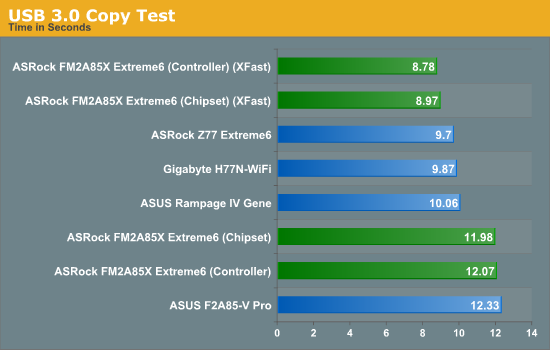
Similarly with USB 3.0, under Windows 7 and despite the AMD systems having native USB 3.0, there is a distinct dichotomy between Intel and AMD, even with controllers on Intel products (like the RIVG). The ASRock still remains competitive with XFast USB however.
DPC Latency
Deferred Procedure Call latency is a way in which Windows handles interrupt servicing. In order to wait for a processor to acknowledge the request, the system will queue all interrupt requests by priority. Critical interrupts will be handled as soon as possible, whereas lesser priority requests, such as audio, will be further down the line. So if the audio device requires data, it will have to wait until the request is processed before the buffer is filled. If the device drivers of higher priority components in a system are poorly implemented, this can cause delays in request scheduling and process time, resulting in an empty audio buffer – this leads to characteristic audible pauses, pops and clicks. Having a bigger buffer and correctly implemented system drivers obviously helps in this regard. The DPC latency checker measures how much time is processing DPCs from driver invocation – the lower the value will result in better audio transfer at smaller buffer sizes. Results are measured in microseconds and taken as the peak latency while cycling through a series of short HD videos - less than 500 microseconds usually gets the green light, but the lower the better.

All ASRock products in the past 12 months have given a score below 200 microseconds, which is a great sight to see. Here is no different, and the FM2A85X Extreme6 gives a score of 179 microseconds.
Rightmark Audio Analyser
Rightmark Audio Analyser is a commonly used tool to confirm quality within an audio setup. It tests features such as noise levels, dynamic range, harmonic distortion, stereo crosstalk, and general performance. The nature of the software makes it hard to compare two different setups, unless they are equal (including volume control and effects). Rightmark:AA outputs the scores and gives them a rating from Very Poor to Excellent. We use the Dynamic Range and THD+N results for publication under 16-bit resolution for 48 kHz, 96 kHz and 192 kHz.

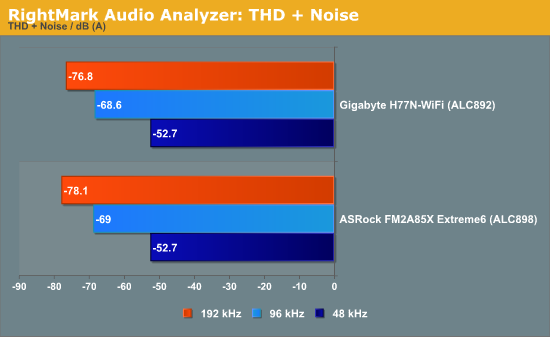










19 Comments
View All Comments
ivica - Monday, December 3, 2012 - link
is there for another reason. There are 3 options to set fast boot on ASrock motherboards, and fastest one disables "entering bios"... so, you can't access bios unless you clear CMOS or through that specific option in AXTU.DanNeely - Monday, December 3, 2012 - link
This seems like an odd feature for a midrange board as opposed to one targeted at the sub-ambient cooling crowd.That aside, I'm curious how it works. Does it just periodically spin the fans up long enough to cycle the air in the case; or is their a humidity sensor that detects when it needs to be cycled.
automaticgiant - Monday, December 3, 2012 - link
I looked at the Realtek website and the feature list for each chip but was unable to determine why one is better other than the power saving. It sounds like "The ASUS gives us another USB 3.0 controller, the ALC892 audio codec and the 8111F NIC - in turn, the ASRock board gives an ASMedia USB 3.0 controller, the better ALC898 audio codec but the 8111E NIC" is saying that the E is crap, but I might be reading into it too much.Merlyn2220 - Monday, December 3, 2012 - link
"Firstly, the amount of components on the top left of the motherboard is insane." This and the following statements are completely wrong. The extra components are likely tuned values of capacitors, resistors and ferrite beads intended to soften clock edges (reducing EMI) and improve high speed stability. As an engineer handling moderate-speed (sub-1GHz) clocks I can say with authority that these components are likely critical to the board's stability and performance. To say that having fewer components helps overclocking is pretty ignorant. /end rant.Rajinder Gill - Tuesday, December 4, 2012 - link
Most of those will be VRM related components. The amount of decoupling that needs to be used depends on the circuit. Generally, better VRM controllers and FETs need fewer output capacitors. The amount of surrounding circuitry for pulling legs of the buck controller down or up varies also - some buck controllers don't need a lot of external hardware to function.cosmotic - Monday, December 3, 2012 - link
In that last product shot, is that on glass or what?Wardrop - Tuesday, December 4, 2012 - link
No. It's the official ASRock product shot. You can tell it's two images layered one on top of the other. They've just added a very rough reflection and shadow effect in Photoshop.abianand - Tuesday, December 4, 2012 - link
What is AMD A10-4800K?- Power Consumption and Post Times page
cyrusfox - Tuesday, December 4, 2012 - link
Well it is obvious he meant the 5800k from the other pages but yes that is a typo in that table there.Garestle - Thursday, March 26, 2020 - link
Check this <a href="http://www.google.com/">google</a> and get everything you need.